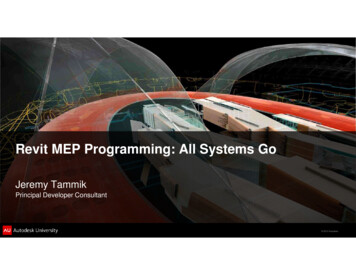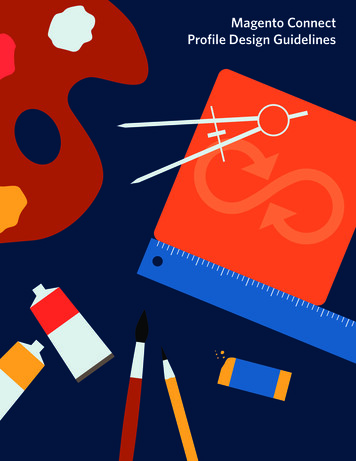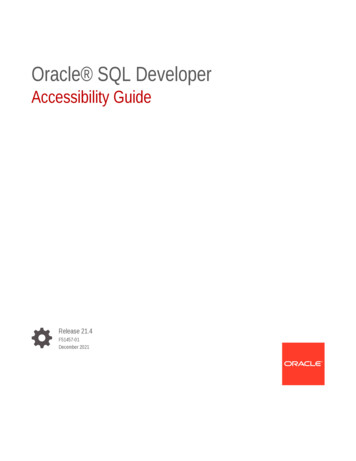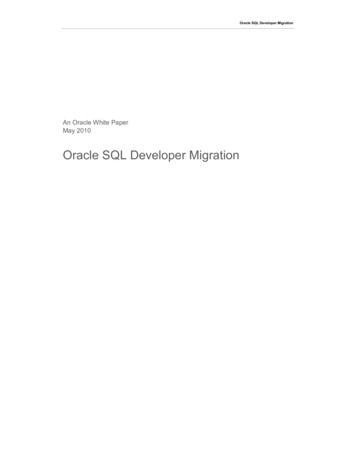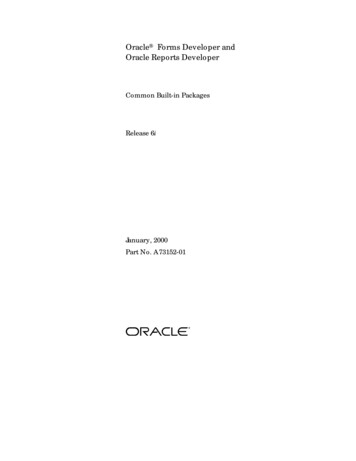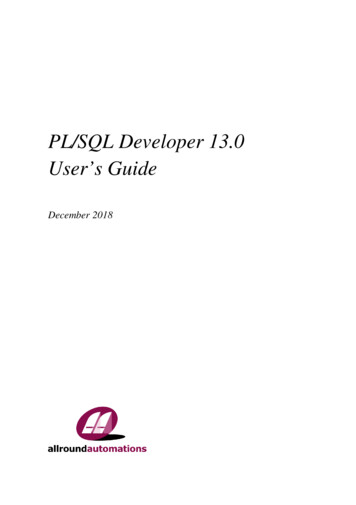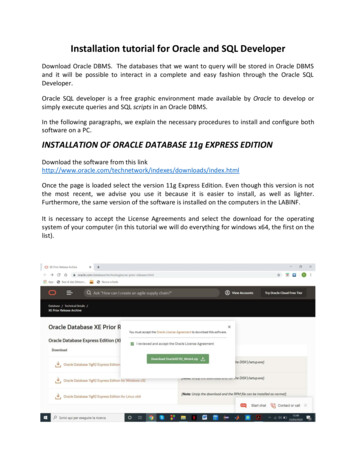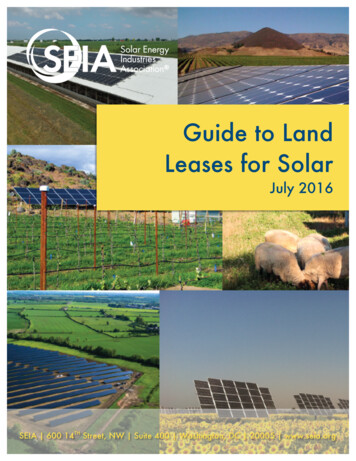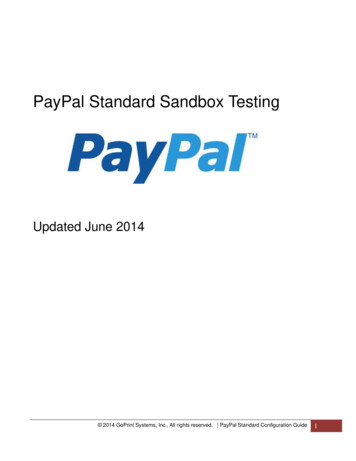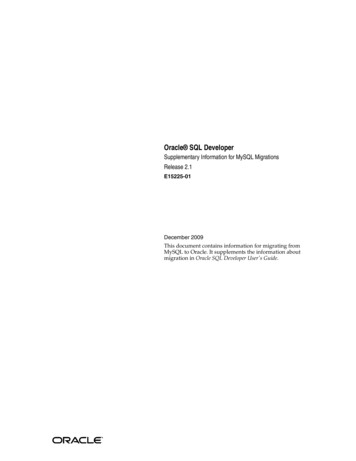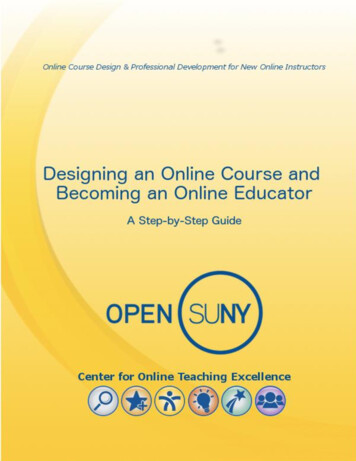
Transcription
Version 3.0May 2015Revision History:Version 1.01.0aPiloted with March 2006 Sloan-C WorkshopPiloted with February 2006 UAlbany Summer Gen Ed Pilot Program1.0b1.0c1.0dPiloted with February 2007 UAlbany Summer Gen Ed ProgramPiloted with February 2008 UAlbany Summer Gen Ed ProgramUsed with permission February 2009 for the UAlbany Summer Gen Ed ProgramUsed with permission February 2010 for the UAlbany Summer Gen Ed ProgramUsed in UAlbany ETAP687 summer course 2008Used in UAlbany ETAP687 summer course 2009Used in UAlbany ETAP687/640 summer course 2010-14Version 2.0Version 3.0Revised and Retitled August 2014Edited May 2015This manual provides a step-by-step process and instructional design guidelines for the design of aneffective online teaching and learning environment.By: Alexandra M. PickettThis document is made available by Alexandra M. Pickett, under the Creative Commons AttributionNonCommercial-ShareAlike 4.0 International License. To view a copy of this license, 4.0/
AcknowledgmentsSpecial thanks to Peter Shea and William Pelz.To my colleagues who have inspired me to be a better instructional designer, thank you: RobertPiorkowski, John Prusch, Stephen Mann, Rick Costanza, Ruffin Pauszek, Ming Ming Jiang, LarryGreenberg, and Evelyn Ting.To all SUNY Learning Network faculty and the amazing community of SLN campus-based instructionaldesigners (IDs): thank you. It’s been my great privilege to work alongside such skilled professionals,who’ve allowed me to tap into their knowledge, observe their processes and procedures, and unfailinglyand graciously answered my endless questions.Designing an Online Course and Becoming an Online EducatorPage 3
How to use this ManualThis Manual may be used as a step-by-step guide to online course development, or as a referencemanual. It may also be used in conjunction with an online course or workshop, or as a resource in onlinefaculty development activities. While written primarily for those who have never created or taught anonline course, the manual contains information to help experienced faculty improve their courses. Themanual offers a practical “hands on” process that will help you design and teach an effective onlinecourse, including the tips, suggestions, and resources needed to develop and manage online instruction.You will note, however, that the last step in the process is “Evolve.” Iteration, continuous improvement,and ongoing learning are built into this process. So, though you can use this Manual to build and prepareto teach an online course, it is in the process rather than the destination where there is the most value.By emphasizing foundational theory and best practices, the manual presents specific course-buildingactivities designed to assist instructors with course development, organization, and evaluation. The stepsutilized are:1: Reflect2: Connect3: Organize4: Build5: Refine6: Implement7: EvolveOrganization of StepsOverview, Purpose and ObjectivesBackgroundInformation to clarify and support learner capacity to meet objectives.Best PracticesBest practice exercises to enhance understanding, adaptation, and implementation of step objectives.ActivitiesCourse development activities.ReviewA quick recap to reinforce learning and retention of new material.ResourcesHelpful readings, links, presentations and more to support learning and uptake.Designing an Online Course and Becoming an Online Educator4
Table of ContentsACKNOWLEDGMENTS . 3HOW TO USE THIS MANUAL . 4TABLE OF CONTENTS . 5ONLINE COURSE DEVELOPMENT: AT-A-GLANCE . 9INTRODUCTION .10STEP 1: REFLECT . 11OVERVIEW, PURPOSE, AND OBJECTIVES .11BACKGROUND .12READINGS, VIDEOS, AND RESOURCES .13ASSESS YOUR SKILLS .14DRAFT YOUR COURSE CONCEPT .17Course Description Activity .18Course Information Activity.19ONLINE ACTIVITIES .22Online Course Activities .22Online Course Development Activities .22REVIEW .23STEP 2: CONNECT . 24OVERVIEW, PURPOSE, OBJECTIVES .24BACKGROUND .25RESOURCES AND RESOURCES.26CREATE YOUR COURSE INFORMATION DOCUMENTS .27BEST PRACTICES .29General suggestions for presenting content online .29General “Do’s” for Successful Web Page Presentation.30ONLINE ACTIVITIES .31Online Course Activities .31Online Course Development Activities .31REVIEW .32STEP 3: ORGANIZE . 33OVERVIEW, PURPOSE, OBJECTIVES .33BACKGROUND .34READINGS AND RESOURCES .35SYNTHESIZE “CHUNKS” AND DEVELOP YOUR COURSE OUTLINE .36Identify your Course Modules.36What is a course module? . 36Make a List of your Modules . 36How do I go about chunking my course into modules?. 36Name your modules. 36BEST PRACTICES .37Suggestions .37What do I put in my Course Module Overview Documents? . 37Your module overview document should cover the following: . 38ONLINE ACTIVITIES .39Online Course Activities .39Designing an Online Course and Becoming an Online EducatorPage 5
Online Course Development Activities .39Review .40STEP 4: BUILD . 41OVERVIEW, PURPOSE, AND OBJECTIVES .41BACKGROUND .42The Theory: Designing Effective Online Learning Environments .42How People Learn . 42The seven principles of good practice in Online Teaching and Learning . 42Cognitive, Social, and Teaching Presence. 42Class Community . 43READINGS AND RESOURCES .44FROM THEORY TO PRACTICE: DEVISE THE LEARNING ACTIVITIES FOR YOUR ONLINE COURSE .45What is a Learning Activity? .45Identify Your Learning Activities . 46How do I go about identifying the learning activities of my modules? . 46Naming Your Learning Activities . 46How do I best sequence my learning activities within a module? . 46How do I best organize the information in my course? . 47How do I make sure my students know where to go and what to do throughout my course? . 48BEST PRACTICES .49Course Navigation Tips! .49Build a Sense of Class Community .50THE COMMUNITIES OF INQUIRY MODEL (COI) .52Social Presence: What is it? Why is it important? How is it created?.53Teaching Presence.55Instructional Design and Organization . 55Create Areas for Communication/Interaction/Engagement in your Online Course . 57Using Small Groups in Your Online Course. 61Think before you link! . 63Get feedback on your course from your students . 64Accessibility . 66Facilitating Discourse and Interaction . 68Enhance Your Online Content Presentation: Things you can do in your course besides lecture! . 68Enhance Your Online Discussion/Interactions. 75Best Practices in Online Interaction: . 75How do I assess students' interaction in my course? . 78Rubrics . 79Create a Rubric . 79Direct Instruction. 80Confirming understanding through assessment and explanatory feedback . 80Suggested Online Assessment Techniques (OATs). 83ONLINE ACTIVITIES .85Online Course Activities .85Online Course Development Activities .85REVIEW .86STEP 5: REFINE . 87OVERVIEW, PURPOSE, AND OBJECTIVES .87BACKGROUND .88Getting outside feedback and making revisions .88Editing, evaluation, and revision during the development phase of your course . 88READINGS AND RESOURCES .89CHECKLIST: DO A MODULE WALK-THROUGH .90Module Walk-Through Checklist .90CHECKLIST: FINALIZE YOUR MODULES .92Designing an Online Course and Becoming an Online Educator6
Module Finalization Checklist.92CHECKLIST: WALK THROUGH YOUR ONLINE COURSE AS A STUDENT AND REVISE .93Student-level Walk-Through Checklist .93CHECKLIST: PEER REVIEW YOUR ONLINE COURSE .95Peer Reviewer Checklist .95ONLINE ACTIVITIES .98Online Course Activities .98Online Course Development Activities .98REVIEW .99STEP 6: IMPLEMENT . 100OVERVIEW, PURPOSE, AND OBJECTIVES . 100BACKGROUND . 101Getting ready to teach your course . 101READINGS AND RESOURCES . 102BEST PRACTICES . 103Things to think about when teaching in an online environment . 103Tips on getting off to a good start! . 104Getting Started . 104Course management tips to keep students engaged . 106You can support student success in your online course: . 107Final Things to Consider: . 108Keep notes on any changes you want to make to your course . 109FINAL REVISIONS CHECKLIST . 110ACTIVITIES . 111Online Course Activities . 111Online Course Development Activities . 111REVIEW . 112STEP 7: IMPLEMENT . 114OVERVIEW, PURPOSE, AND OBJECTIVES . 114BACKGROUND . 115Things to think about when ending an online course. 115Evaluate your course . 115Things to consider:. 115RESOURCES . 117BEST PRACTICES . 118Review Your Course . 118The OSCQR Rubric . 118Teaching Presence and Class Community: Reflection, Evaluation, & Revision . 118Class Community . 120Teaching Presence . 125Revise your course . 129ONLINE ACTIVITI
This manual provides a step-by-step process and instructional design guidelines for the design of an effective online teaching and learning environment. By: Alexandra M. Pickett This document is made available by Alexandra M. Pickett, under the Creative Commons Attribution-NonCommercial-ShareAlike 4.0 International License.
